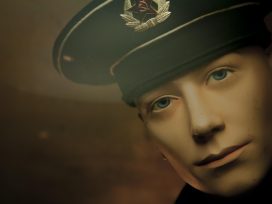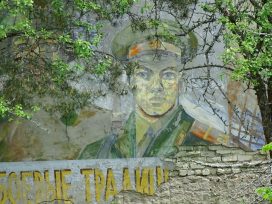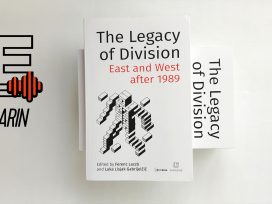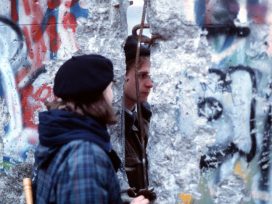The East-West divide is back. The happy hopes at the end of the First Cold War in 1989 for the historic reconciliation of the continent came to naught. Worse still, an ‘Iron Curtain’ is once again being built across the continent, no longer running from Stettin on the Baltic to Trieste on the Adriatic (as Winston Churchill so graphically described it), but from Narva in the north to Mariupol on the Sea of Azov. The physical frontier is reinforced by militarisation, as well as the psychological and political intensification of hostilities that in many ways surpasses that of the original Cold War.
There has also been a major shift in perceptions. In the late Soviet years the West came to be considered the home of development and ultimately the best model of modernity. The countries trapped in the Soviet bloc anticipated a ‘return to Europe’, representing the political and ideological reunification of a continent that was perceived to have been artificially separated. However, this model of the West as the only viable model of progress has given way to disillusionment. For Russia, Europe is no longer considered a desirable model, although this does not mean that there is a desire to break all ties. Equally, the belief that Russia after communism could join the Western fold has now given way to disappointment. The country stubbornly, and for some irrationally, seeks to maintain its independent status as a great power and refuses to adapt to the exigencies of the Atlantic system as historically constituted in the post-war years.
This new East-West divide is increasingly taking on the characteristics of a Second Cold War. Just as the Second World War differed in its geopolitical and ideological postulates from the First, so the Second Cold War is not just the continuation of the First. As with both twentieth-century world wars, the unresolved problems at the end of the first gave rise to the second. In the three decades since 1989, hopes of overcoming the East-West divide have not been fulfilled, and in many ways the gulf today is wider than it has ever been.
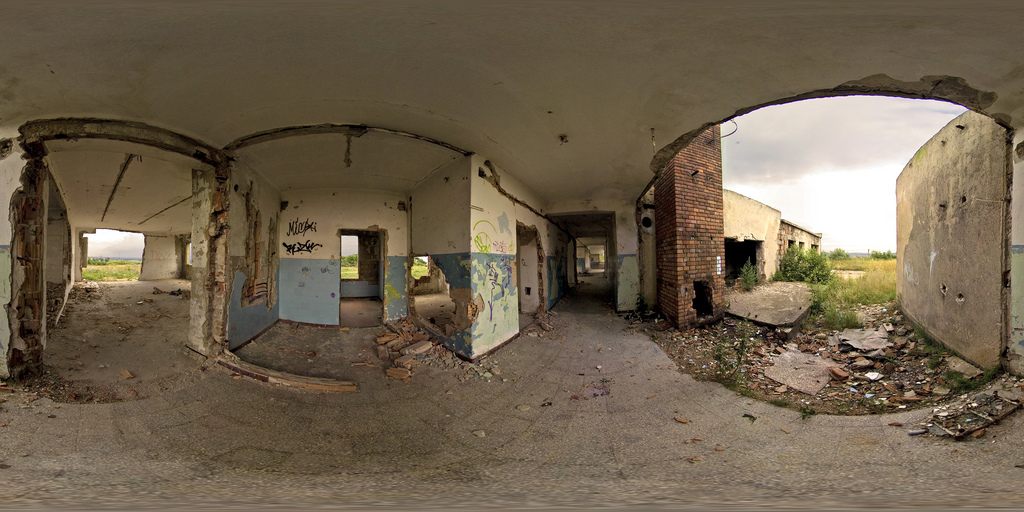
Ruins of an abadoned S-75 Volkhov SAM site close to Budapest, Hungary. The squadron was named MN3121 11/8 with the call sign “wheat”. Photo by Zoltán Bánfalvy. Source: Flickr
1989 as a false dawn
Europe in 2014 once again entered a period of confrontation and division. For some, this represents the onset of a new Cold War, a period of entrenched confrontation accompanied by the rhetorical condemnation of the opponent. Others are sceptical, arguing that the appropriation of the term ‘cold war’ is an abuse of history that misunderstands the realities of the present situation. There is no longer the old ideological division between capitalism and communism characteristic of the First Cold War, and Russia is just a shadow of the superpower that was once the former Soviet Union. However, it is clear that elements of a cold war have returned to Europe, although this does not mean the return of the Cold War.
This is why the idea of a Second Cold War is useful, since it both seeks to identify the elements of continuity while revealing what is different. The continuities include the militarisation of the frontier between the North Atlantic Treaty Organisation (NATO) and Russia in the Baltic, military exercises to prepare for conflict between the two, a nuclear stand-off based on the classic postulates of deterrence (above all mutually-assured destruction, MAD), accompanied by intense propaganda designed to delegitimize and undermine the other. The entire arms control mechanism is being dismantled and replaced by the language of ultimatums. In many ways this renewed confrontation is more dangerous than the original conflict.
How did we manage to reproduce a conflict that so many agreements had vowed to prevent? My basic argument is that the 25 years of the cold peace between 1989 and 2014 failed to resolve any of the fundamental problems of European security and political identity. For Russia, NATO enlargement represented not only a betrayal of the verbal assurances apparently given at the time of German unification in 1990 that the alliance would not move ‘one inch to the East’ of the former East German territory, but above all represented a reckless provocation that only intensified the security dilemma that it was intended to avert. From this perspective, NATO’s existence is justified by the need to deal with the consequences of its own existence.
From the perspective of the Atlantic powers, the enlargement of the zone of peace and security would ultimately work to Moscow’s benefit too, avoiding a return to the endless inter-war conflicts between small states and the tensions between the great powers. By contrast, Russia remained loyal to a Yalta-type vision of great power politics managed by the UN Security Council, although this did not imply an attempt to reconstitute something akin to the old Soviet bloc. It did mean, however, recognition of Russia’s great power interests in the eastern part of Europe and continued status as a great power in world affairs.
There have been three major periods of post-war European history. The original Cold War lasted from the late 1940s to 1989; followed by a quarter century of the cold peace, in which the European Union and NATO enlarged, but in which Russia became increasingly disgruntled; and then after 2014 the full-scale onset of a Second Cold War, in which we now find ourselves. This is an era of renewed confrontation, marked by sanctions imposed on Russia by the Western powers, while Russia seeks new alignments and partnerships in the East. The Ukraine crisis of 2014 was just the catalyst that brought out the underlying tensions. Today the militant anti-Russian regime in Kyiv, embittered above all by the loss of Crimea, acts as a powerful wedge driving Russia and the West even further apart to exacerbate the East-West divide. The combination of geopolitics and democratisation since Ukraine became independent in 1991 means that tensions were there from the start, paving the way for the dominant model of Ukrainian state building. This entails the fundamental rejection of partnership with Russia in favour of a putative ‘European choice’.
The collapse of the state socialist model of modernity represented by the Soviet system did not mean Russia’s seamless return to what Gorbachev-era intellectuals called ‘the main highway of history’. It turned out that history has many highways and byways. At the end of the Cold War Russia aspired to join the Historical West, but believed that its very act of joining would change its character and that through a process of transformation a Greater West would emerge.
Russia asserted that it was a senior constitutive member of international society, a founding member of the UN and a permanent member of its Security Council, and sought to lever this to transform the Historical West into a reconstituted order. Moscow argued that it had done more than any other state to end the futile Cold War, and therefore deserved some sort of special status in a reconstituted Greater West. The self-willed disintegration of the Soviet bloc represented a pledge of Moscow’s bona fides as a member of the expanded Western order.
This also applies to the regional context, where Mikhail Gorbachev’s idea of a ‘common European home’ (today called Greater Europe) would have established a co-operative pan-European community. Instead, Moscow was offered guest membership of the existing enterprises – the Historical West and the smaller Europe represented by the European Union. For historical, status, geographical and security reasons, this type of membership was not acceptable – Moscow was not ready to enter into some sort of neo-colonial apprenticeship to ultimately join the Historical West. From this foundational difference all the rest flows.
There was a fundamental incompatibility in perceptions. Moscow claimed a reward for ending the Cold War, but that is not how international politics works. From the Western perspective, the Soviet Union and then Russia was a failing power. The country had exhausted itself in the arms race and its economic and political order was dysfunctional. A victory discourse was at first eschewed, but it soon made itself felt. More than that, the countries recently liberated from the Soviet yoke sought to hedge against a revival of Russian imperial power, and hence clamoured to join Western institutions. The West as a whole saw no reason to make concessions to what appeared to be a spent power, and it made sense to secure its positions while the going was good. This did not mean that Russia was treated as a defeated power, and numerous initiatives, ranging from the NATO-Russia Founding Act on Mutual Relations of 1997 to the establishment of the NATO-Russia Council in 2002, sought to create a framework for interaction. As far as Russia was concerned, these were palliatives, intended to soften the failure to transform European international relations after the Cold War, and to mitigate the consequences of what appeared to be the inexorable advance of the Atlantic power system to Russia’s western borders.
There are understandable reasons why the Historical West refused to transform itself through Russian membership. There were fears about norm dilution, especially concerning human rights; institutional incoherence if Russia joined or became affiliated with such bodies as NATO; and concern about the loss of US leadership, especially in crisis situations (as in the various conflicts in the former Yugoslavia). At the theoretical level, the US-led liberal international order effectively claimed to be synonymous with international society. In this conception, world order emerges not out of cooperative (solidarity-based) inter-state practices regulated by international society, but out of American leadership of the liberal international order. The institutions of international society and the liberal international order are effectively fused. This does not mean that the US-led coalition gets its way all the time – in fact, the UN, as a product of the Yalta order, remains a recalcitrant body because of the veto powers wielded by Russia and China, as well as their allies in the global South.
This is what gives rise to divergence between multilateral processes and the western hegemonic formation. Relations between the US and the UN have been far from easy, prompting complaints by US legislators about the disproportionate burden assumed by America. The US contributes 22 per cent of the main UN budget and nearly 29 per cent of peacekeeping costs. As a result, there have been various attempts to bypass the UN’s authority through various ‘coalitions of the willing’, as in Iraq in 2003. The establishment of the Community of Democracies in 2000 was also intended to achieve a similar autonomy from international society in the normative sphere.
From East-West to North-South
Elements of the Cold War have been restored, but that only describes part of the current situation. The Second Cold War is part of a broader shift of power in international politics away from the Historic West, and is a symptom of that shift. The renewed division of Europe is ultimately only a relatively minor, and undoubtedly archaic, part of a global shift in the balance of power and ideology. Although the Second Cold War dominates Europe, something far bigger is taking place at the global level. There is a shift towards what some call multipolarity but which in practice is broader than that – the transition to a world of multiple spatial and temporal orders (multi-orderness). Amitav Acharya calls this a ‘multiplex world order’. Thus it is fair to talk of a new East-West divide, but only if we confine ourselves to Europe.
Recent shifts in international politics reflect deeper changes in global affairs. There is a slow but ineluctable structural shift of economic power from the Atlantic to the Pacific basin. In particular, the return of China as one of the world’s top economic powers cannot but change the structure of global power, reinforced by India rising up the index of economic powers. China has now emerged as the only potential peer competitor to American hegemony, and for that reason John Mearsheimer predicts that the two will inevitably come into conflict. The US will do everything in its power to contain China’s rise, while China will consistently push back against the US in the South China Sea and elsewhere.
If the focus is on brute military power, then those who dismiss ‘declinist’ interpretations of America’s status are undoubtedly right. The US remains overwhelmingly the predominant global power, and this is unlikely to change soon. However, we are now witnessing an acceleration of the long-term decline of American and Atlanticist ideational hegemony, within the West and beyond. The emergence of social movements dissatisfied with the neo-liberal hegemony established since the 1970s is reflected in the ballot box, including the Brexit vote of 23 June 2016. Often described as ‘populist’ challenges, Ernesto Laclau is right to note (drawing in particular on Latin American experience) that in conditions of political closure, populism becomes the vernacular in which new ideas are articulated to challenge the failings of the ruling system. National populism represents a challenge from both the left and the right to the economic and political relations consolidated after the end of the Cold War.
On a global scale the old East-West divide no longer makes much sense, since there are major new players. The developed North, as politically constituted in the form of the Historical West, no longer enjoys its former primacy. If hopes of overcoming the East-West divide have in part been fulfilled, then it is not in the way envisaged by idealists at the end of the Cold War. Instead of Europe overcoming the division by becoming whole, accompanied by a pan-continental vision of European unity and leadership in the world, the Historical West has expanded and radicalised its vision of itself; while in the East Russia is now at the heart of the creation of an alternative world order. This is based not so much on anti-Western positions as on the view that the hegemony of any single order leads to distortions and ultimately hubris. The demand is for pluralism in the international system, and on this basis Russia and China have forged an anti-hegemonic alignment.
The unipolar moment is giving way to the clash of political orders. This is why the Eastern pole in Europe is assuming a Greater Eurasian dimension, and even more broadly, becoming part of Greater Asia. The traditional East is becoming part of a southern anti-hegemonic alignment. The outlines of such an alternative order were apparent at the meeting of the RICs powers (Russia, India and China) on the sidelines of the G20 summit in Buenos Aires (30 November–1 December 2018), the first such trilateral meeting for twelve years.
Russia has advanced the principle of multipolarity since at least the mid-1990s, and it was a central idea of Yevgeny Primakov as foreign minister between January 1996 and September 1998, and then when he was prime minister until May 1999. In fact, the idea of a RIC alignment belongs to him, as part of his ‘competitive coexistence’ model of post-Cold War international relations (harking back to Nikita Khrushchev’s idea of ‘peaceful coexistence’). It must be stressed that multipolarity and multi-orderness are not the same. Multipolarity refers to multiple centres of power – poles – in the international system, all operating according to the same model of politics. Typically, multipolarity is examined through a realist, or even geopolitical, lens, with all states seeking to maximise their relative position in the anarchical system. This can at times be achieved through some sort of concert of powers as established after the Congress of Vienna, and in a rather more attenuated form, at Yalta and Potsdam at the close of the Second World War.
A multi-order system is one where there is a different dynamic to the international politics of the different orders. The different orders represent different paradigms of the international system, with different views about the structure of the system and the appropriate behaviour and logic of action. Today we have the US-led liberal international order as well as a putative anti-hegemonic alignment encompassing to varying degrees Russia, China, India and others states in the Shanghai Cooperation Organisation (SCO) and the BRICS (Brazil, Russia, India, China and South Africa) association, as well as the revived Non-Aligned Movement. Some may even add political Islam as a possible third order, with the attempts to recreate a Caliphate in the form of an Islamic State as the most vivid manifestation of a radical alternative order. A number of different ‘new world orders’ represent different ideas about how political space should be organised on a global scale.
The emerging anti-hegemonic alignment refuses to accept the claim of the liberal international order that it is synonymous with order itself. Instead, Moscow, Beijing and their allies in what used to be called the ‘Third World’ (a putative world order in itself) stress the autonomy of the institutions of international society. Issues of human dignity, fairness in international trade and finance, and indeed the survival of the planet itself belong to all of humanity, and although the major multilateral institutions were shaped by the victorious allies at the end of the Second World War, they represent a universalism that cannot be the property of any one order. For the new global South (the post-Western world), there can be order without hegemony.
Conclusion
The Russian leadership under Boris Yeltsin asserted that Russia would transform itself into a liberal and market democracy, but it would do so in its own way and at its own pace. Above all, it argued that the transformation should be mutual, including a transformation of the system of European international relations. The West insisted that Russia had to transform itself; while Russia riposted that it would do so, but as part of a broader transformation. Russia hoped that its membership would transform the Historical West (with the Atlantic powers and institutions at its core) into a Greater West in which Russia would be a constituent member and thus enjoy all the rights of a co-founder. The idea of Greater Europe displaces the idea of the EU as the sole representative of Europe in favour of a more plural model, in which the EU would be part of a broader pan-European community. Both the Greater West and Greater Europe ideas are based on a dialogical approach to politics – the view that engagement transforms both subjects. Instead, the West tried to stay the same and enlarge (a monological perspective); while Russia was to change and assume a new power and normative identity.
The fundamental process at the end of the Cold War became enlargement of the Atlantic community. By contrast, Gorbachev and his successors in Russia sought transformation, a negotiated end to the institutional and ideational structures of the Cold War in which Russia would become a founder member of a new political community. Instead, all that was on offer (and as far as the Western powers were concerned, it was quite a lot) was associate membership in an existing concern. No one really believed that Russia could join NATO without changing the character of the organisation and of the whole Atlantic system. There were understandable fears that Russia’s membership would lead not to the positive transformation proclaimed by Gorbachev but to a degradation of institutional coherence and normative principle. Fully-fledged Russian membership would have meant constituent authority and veto powers. In the post-Cold War era there were simply not enough western leaders, let alone military planners, ready to take the risk and weaken (from their perspective) a functioning enterprise in favour of an uncertain and possibly dangerous alliance with Russia. Hence there appeared to be ‘no place for Russia’ in the post-Cold War order, giving rise to the cold peace.
Once it became clear that there would be no transformational politics at the end of the Cold War and that the logic of enlargement would prevail, Russia was faced with the choice of either adapting to the Historical West and the smaller Europe as a subaltern, or of asserting its autonomous great power and normative identity. Yeltsin and Vladimir Putin at first tried to finesse the question by finding some sort of middle course, but in the end Putin unequivocally advanced the view that Russia would be an independent sovereign power in the international system. This gave rise to a neo-revisionist foreign policy: one that remained committed on the vertical axis to the institutions of international law and governance, above all the UN; but in horizontal relations with other states it challenges the hegemony of the US-led liberal order. This inevitably brought Russia into confrontation with the Atlantic system, but now balanced by the creation of an anti-hegemonic alignment with China and some other states. The East-West divide is back, but it no longer determines international politics. East-West divisions are now only a relatively small part of the global clash of world orders.
